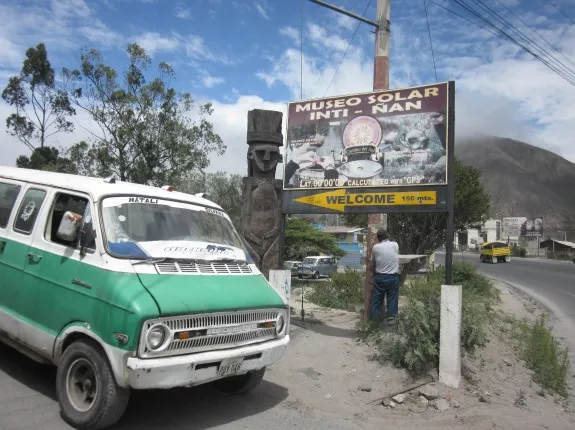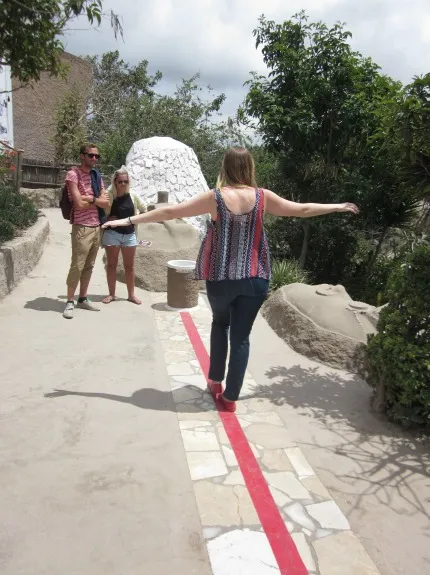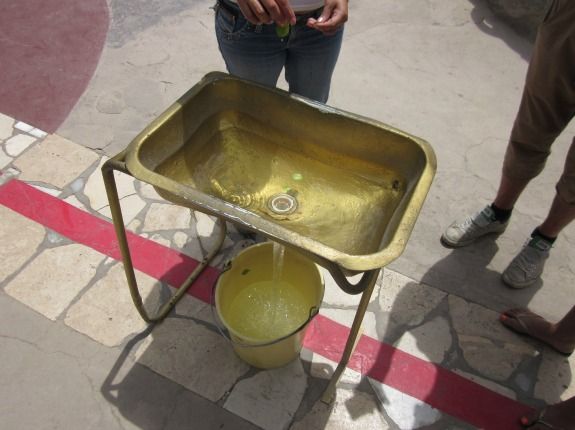Much Ado About Nothing at the Equator
Just north of Quito stands a grand and glowing tribute to one of Ecuador’s proudest features: the Equator. The problem is, it was built in the wrong place
/https://tf-cmsv2-smithsonianmag-media.s3.amazonaws.com/filer/20130130113135EcuadorEquatorBikeLineSMALL.jpg)
About 15 miles north of Quito, a palatial iron gate on the west side of the highway opens onto a long, stately driveway leading across a prim and trim government property, past statues of acclaimed national leaders and, after about 200 yards, to the base of a nearly 100-foot-tall brick-and-mortar monument, grand enough to produce tears, called the Mitad del Mundo—“Middle of the World.” A yellow painted stripe representing the line of zero degrees latitude even runs up a walkway and bisects the monolith, which was built in 1979 and stands today as a premier tourist attraction, and a grand and glowing tribute to one of Ecuador’s proudest features: the Equator.
The problem is, they built the thing in the wrong place. The Equator is actually several hundred feet to the north, as determined by modern GPS technology that wasn’t available to the earlier surveyors of the region. As long ago as 1736 scientists were exploring Ecuador, with, among other goals, the aim of defining and marking the Equator. At some point, the current Mitad del Mundo line was painted proudly on the ground. But in recent decades, the embarrassing truth emerged: The Equator actually, and without a doubt, crosses the highway just up the road, where the property owners surely rejoiced upon hearing the news (and took their own GPS measurements, as they claim they have done) and have since built their own rather campy but perhaps more accurate attraction.
As for the grandiose government monument just to the south, what’s built is built, and, as the saying goes, no publicity is bad publicity. And so the yellow painted line that leads into the museum at the base of the Mitad monument is still declared to be the waistline of the Earth and draws hundreds of thousands of tourists every year. Here, they walk the line, straddle it, try and balance eggs on it and shake hands over it.
But I didn’t do any of those things. I didn’t enter the museum, either—not because admission was $3 but because I didn’t see the point. Nor did I see any point in getting coffee at the Equator, buying “Mitad del Mundo” trinkets at the gift shops on the Equator, eating lunch at the Equator, sitting down for a beer at the Equator or petting an alpaca at the Equator (the little camelids roam the premises). Because I wasn’t on the Equator and it all would have meant nothing. Carved into the monument is the site’s elevation (2,483 meters) and longitude (78 degrees, 27 minutes and eight seconds west—or so they say). But these somewhat arbitrary numbers are made even more so since, well, this isn’t the Equator.
Still, I did as many visitors to the Mitad do and had my passport stamped by the lady working the museum admission booth so that I could prove to the folks back home that I had actually stood on the Equator—well, almost.
“Does the stamp say ‘Mitad del Mundo, Mas o Menos’?” Alistair Hill joked minutes later, just after I met him and several other British travelers on the steps before the monument.
Hill and his girlfriend Jess Swan, both from England and now backpacking through South America for several months, gazed up at the hulking, majestic thing. They had heard the rumors that the attraction was not all it is claimed to be but made the trip from Quito anyway, splitting a cab four ways for $40.
“How did they get it so wrong?” Hill said. “Why didn’t they just flush a toilet on each side to make sure they had it right? It makes you wonder if the Meridian really passes through Greenwich.”
Hill’s friend Chris Leigh joked, “So, what else in the world have they got wrong? The South Pole? The North Pole? The Tropic of Capricorn? That’s probably 100 miles out of line. Turns your world upside-down, doesn’t it?”
But for all the pomp and circumstance, gravity and grandeur of the Mitad del Mundo, that a huge mistake has been made is freely admitted today, and the officials who work at the site readily tell visitors who inquire where to find the actual Equator.
“Turn left at the gate, and it’s 100 meters on your left,” the guard at the entrance told me as I was leaving.

You have to watch closely, but you’ll see it—a sign reading “Museo Solar Inti-Nan.” The sign assures you that you are now at zero degrees, zero minutes and zero seconds—neither north nor south of the middle of the world. The sign adds that these figures were “calculated by ‘GPS.’” It comes off as a smirking insult directed at the government site just down the road, but the sign is only being honest. A humble dirt trail leads visitors up a ravine, across a small bridge and into the outdoor museum area. While guests are free to wander at the Mitad del Mundo site, at the private museum visitors are quickly asked for $4 and then ushered into a small tour group, whether you want the service or not. I joined Amy Jones of Texas and Stefania Egas of Quito, and our English-speaking guide led the way. Much of the tour, through wood huts and artifact collections, has nothing whatsoever to do with the Equator. We saw a pen full of guinea pigs, a shrunken human head, a soggy dead boa constrictor in formaldehyde, a collection of totem poles and an exhibit featuring native folks of the Amazon.

But we finally got to the feature attraction—the Equator. It is represented by a red line, along which have been mounted a sundial, a spinning globe, nail heads on which one may try and balance an egg and—the grand fireworks of the tour–a full wash basin used to demonstrate the way that draining water supposedly swirls in a particular direction in each hemisphere. There has been much debate about this phenomenon. The Coriolis effect, a function of motion and the curvature of the Earth, is real, a phenomenon by which free-moving objects in the Northern Hemisphere appear to veer toward the right and those in the Southern Hemisphere to the left. At zero degrees latitude, the effect does not occur. This is why, for example, hurricanes wither and dissipate when they drift too close to the Equator.
But whether toilets and sinks, at their small scale, can demonstrate the Coriolis effect isn’t clear, though most experts say that the Coriolis effect does not visibly affect moving water over such a short distance as the diameter of a sink or toilet. Yet our young mono-toned tour guide, drably repeating a show she had probably given many times before, made it happen. On the Equator, after she pulled the drain plug, the water shot straight through without a swirl in either direction. Ten feet to the south, the water drained in a clockwise gyre. And just to the north, the water went down in a counterclockwise whirlpool. I suspect there was trickery at play—possibly by a hand furtively dipped into the basin and slyly setting the appropriate flow direction when we weren’t watching. I walked away frustrated, if not wowed, and I admit: The 100-foot-tall monument of the government, though a big fat mistake, is a greater site to see.
But just when we think we’ve got the whole matter sorted out and the Earth perfectly bisected, I discover this blog post from a science-savvy traveler named Adam Rasheed, who claims we’ve all been duped twice over. In 2006, Rasheed wrote a blog entry for a science and technology firm called Global Research in which he described visiting both of the equatorial sites, being skeptical of the private museum’s claims of legitimacy and promptly taking equatorial matters into his own hands using a GPS device. Rasheed concluded that the true Equator was still farther up the road, and here he and a friend built their own equatorial monument of plastic drink bottles and rubbish. Whether Rasheed had it right seems, by now, doubtful—not that it really matters. Because if Ecuador builds the 5,000-foot-tall spire that a New York architect proposed be erected on the Equator, then that would be the destination most worth paying to see—whether they place it exactly at zero degrees latitude or not.
Perhaps there is only one thing certain in this foggy fuss over the Equator: The more monuments and museums the merrier. If you think you can improve upon the existing measurements, let us know in the comment box below.

Planning Your Next Trip?
Explore great travel deals
Smithsonian magazine participates in affiliate link advertising programs. If you purchase an item through these links, we receive a commission.
/https://tf-cmsv2-smithsonianmag-media.s3.amazonaws.com/accounts/headshot/Off-Road-alastair-bland-240.jpg)
/https://tf-cmsv2-smithsonianmag-media.s3.amazonaws.com/accounts/headshot/Off-Road-alastair-bland-240.jpg)